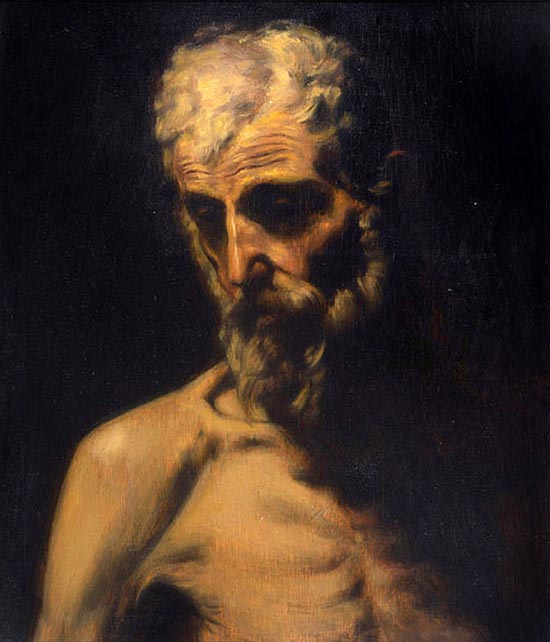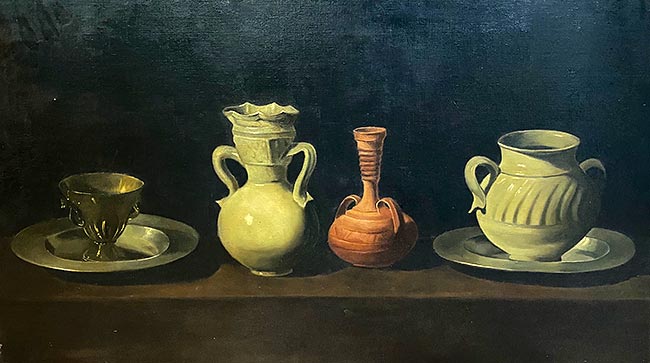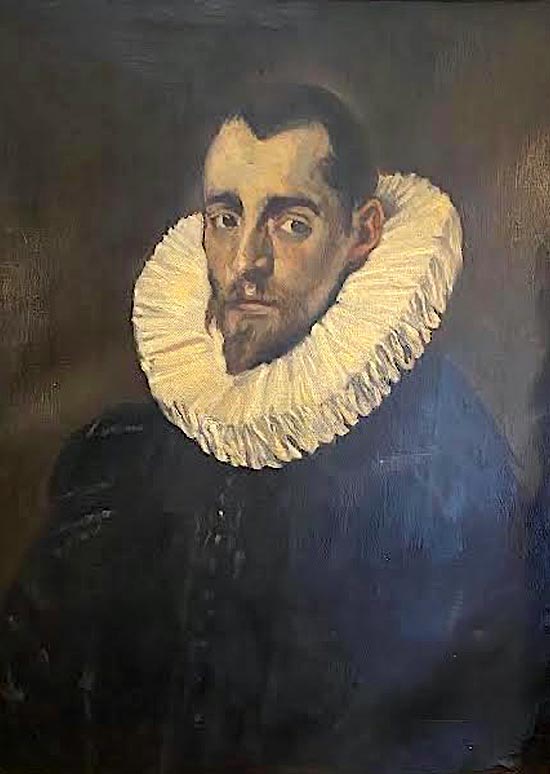28 October
CONFERENCES ON THE FIGURE OF WOMEN
The Prado Museum in the trainingof Navarrese artists: the copyists' record books.
José Javier Azanza López
Chair de Patrimonio y Arte Navarro
The apprenticeship period forms part of the degree programof every painter, and in this process the "copying" of the great artists is fundamental, allowing the study of drawing and colour, composition, technique, the problems they faced and the solutions they found. At final, painters learn to paint by painting, and copying the masters is fundamental in their subsequent artistic career.
In this general context, the great art galleries became, from the moment they were opened to the public, the setting for trainingfor a multitude of artists who came to their rooms to copy their paintings. One of these galleries was the Museo Nacional del Prado, which from the last quarter of the 19th century had regulations governing copyists, according to which their names were recorded in the so-called Register of Copyists, in which entries were recorded with requests for copies from each painter.
The reality of the copyists - both in their training and professional aspects - is reflected in numerous articles in the press and illustrated magazines of the first decades of the 20th century, with special emphasis on the presence of women in the rooms of the Prado, most of whom were students of Fine Arts who studied the technique of the masters as part of their apprenticeship. Among them is a groupgroup of Navarrese women painters whose names are recorded in the copyists' books: Adela Bazo, Rosa Iribarren, Elena Goicoechea, Lourdes Unzu and Isabel Baquedano. We leave Elena Asins, born in Madrid but adopted from Navarre, for another occasion. In our analysis, we follow the path marked out by researchers such as Francisco Javier Zubiaur, José María Muruzábal and Iñaki Urricelqui, and Adelina Moya and Ángel Bados for the figure of Isabel Baquedano.
A first reference letteris provided by Adela Bazo Cunchillos (Cascante, 1905-Buenos Aires, 1989), whose name appears in the Prado's records for 1929 and 1930, and later in 1945, although in the latter case she did not copy a specific work but an interior from conference roomin which she captured an overall view. The 1929-1930 copies correspond to four works by Juan de Juanes(The Last Supper), Murillo (La Dolorosa) and Goya(La maja y los embozados; La vendimia or El otoño). A photograph included in a articleby Salvador Valverde ( Crónica magazine, June 1931) sampleshows a young woman making a copy of the Goyaesque grape harvest that could perhaps be identified with the Navarrese painter.
A contemporary of Adela Bazo is Rosa Iribarren (Tudela, 1894-Madrid, 1958), who, after an initial trainingin her native city with Miguel Pérez Torres, moved to Madrid in 1924 with a scholarshipfrom the Provincial Council of Navarre to continue her painting studies programs of study. Her teachers there were the Cordovan painter Julio Romero de Torres and the Valencian Cecilio Plá. Rosa Iribarren is recorded as a copyist at the Prado in two different periods: the 1920s, corresponding to her artistic training; and the 1940s, when she worked as a professional copyist supported by Natalio Hualde from Pamplona, an institution among the Prado's professional copyists. The sum of the two periods gives a total of 24 paintings (11 in the first and 13 in the second), among which his preference for portraiture as a pictorial genre stands out (21 of the 24 copies are portraits) and his admiration for El Greco, Velázquez and Goya, although he also copied works by Flemish, Italian, German and French artists. Rosa Iribarren's copy of the Portrait of Tiburcio de Redín y Cruzat (attributed to Friar Juan Andrés Rizzi) is in the Palace of Navarre, as well as the copy of a Saint Cecilia by the Flemish painter Michiel Coxcie, which she gave to the Tudelan Philharmonic Society in 1925.
Elena Goicoechea (Pamplona, 1922-2013) belongs to a later generation. After her initial trainingin Javier Ciga's workshop, she travelled to Madrid in the 1940s and her name appeared in the Prado's registers of copyists in 1943, 1947 and 1949. The guarantors who guaranteed his application, as required, were the Almería sculptor Juan Cristóbal González Quesada and the Madrid painter Eduardo Chicharro y Agüera.
Elena Goicoechea copied four works from the Prado by José de Ribera(San Andrés), Zurbarán(Still Life with Crockery), Anton van Dyck(Portrait of a Man) and Goya(La Shrine of Our Lady of Fair Lovede San Isidro el día de la fiesta). The copies of San Andrés and Bodegón con cacharros (Still Life with Crockery) have been preserved, which reveal the painter's skill in capturing the physical features of the human body and the tactile qualities of the objects, as well as her skilful handling of light in her contrasts of chiaroscuro; This is also evident in her copies of other works from outside the Madrid gallery, such as Tintoretto's Portrait of the Procurator Jacopo Soranzo, the original of which is in the Castello Sforzesco in Milan.

Elena Goicoechea. Copy of Saint Andrew, by José de Ribera. 1943. Private collection.
Elena Goicoechea was joined in Madrid by her friend Lourdes Unzu (Pamplona, 1924-2019), also a pupil of Ciga's, whose trainingas a copyist is documented in the galleries of the Museo del Prado and the Museo de Arte Moderno. In the case of the Prado, with Eduardo Chicharro as guarantor, her name appears in the records for 1946, 1947, 1949 and 1951, a period in which she copied a total of 13 works by Titian (1), El Greco (1), José de Ribera (1), Zurbarán (1), Velázquez (2), Alonso Cano (1), Murillo (2), Goya (3) and Vicente López (1). In the case of the Museum of Modern Art, Leonardo Alenza and Eduardo Rosales were the painters copied. A good issueof copies by Lourdes Unzu have been preserved, in which her ability to deal with different artists and pictorial genres (religious painting, genre painting, portraiture, still life) stands out, in compositions that are not without difficulty, such as Titian's La Dolorosa con las manos cerradas ("The Dolorosa with Closed Hands "), Velázquez's El bufón ("The Jester ") and Rosales's Testamento de Isabel la Católica ("The Testament of Isabella the Catholic "). In the case of Zurbarán's Still Life with Pots and Pans, he copied it on at least two occasions in 1947 and 1949.

Lourdes Unzu. Copy of Still Life with Crockery, by Zurbarán. 1947 y 1949. Private collection.
The list of Navarrese painters registered as copyists at the Museo del Prado is completed by Isabel Baquedano (Mendavia, 1936-Madrid, 2018), with an extensive period from 1952 to 1963, in which the painter and restorer of the Prado Gonzalo Perales Soriano, and the painter, engraver and restorer Fernando Labrada Martín are listed as guarantors. The Navarrese painter copied a total of 12 works by El Greco (1), Rubens and Brueghel the Elder (1), Velázquez (3), the circle of Frans Ykens (1), Alexander Coosemans (1), Murillo (1), Jean-Antoine Watteau (1), Claude-Joseph Vernet (1), Luis Meléndez (1) and Goya (1). Those corresponding to El Greco's Portrait of a Young Gentleman and Velázquez's Portrait of Philip IV are preserved.
Isabel Baquedano was a new departure from previous painters in that, in addition to the usual genres of religious and genre painting, portraiture and still life, she added mythological painting(The Spinners or the Fable of Arachne, by Velázquez) and landscape painting(View of the Garden of the Villa Medici in Rome, by Velázquez; Marina: View of Sorrento, by Claude-Joseph Vernet). And in contrast to the traditional dominance of the Spanish school, the Flemish and French schools are also present, with three and two works respectively. Even beyond genres and schools, the names of Rubens and Brueghel the Elder, Frans Ykens, Alexander Coosemans, Jean-Antoine Watteau, Claude-Joseph Vernet and Luis Meléndez open up the panorama of Navarrese copyists in the Prado.

Isabel Baquedano. Copy of Portrait of a Young Gentleman, by El Greco. 1962. Private collection.
In an overview of the presence of Navarrese women painters in the Prado's records of copyists, evaluation, we can see how, from a chronological point of view, Adela Bazo and Rosa Iribarren (1945), Rosa Iribarren and Lourdes Unzu (1946) and Elena Goicoechea and Lourdes Unzu (1947 and 1949) coincided in the galleries of the Madrid museum. issueThe total number of artists copied by the Navarrese painters is 24, and the works amount to 57 paintings. The most copied artists are Velázquez (10 works), Goya (9 works) and El Greco (7 works), followed by Murillo and van Dyck, with 4 works each. In terms of pictorial schools, the Spanish school clearly dominates, to which 70% of the copied artists belong, or in other words, 40 of the 57 copied paintings, followed at a distance by the Flemish (16%), Italian (5%), French (5%) and German (4%) schools. Finally, portraiture (47%) dominates the pictorial genres, followed by religious painting (25%) and genre painting (14%), with still life (9%), landscape (3%) and mythological painting (2%) being less common.
In conclusion, the Madrid training of this group of Navarrese painters will be of great importance in their future artistic development, and their record as copyists in the Prado reveals their dialogue with the great masters, showing their preference for certain artists, schools and pictorial genres. This work is only a first approach to a topic that should be approached in depth and give new fruits in the future.
